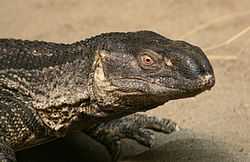Rock monitor
| Rock monitor | |
|---|---|
 | |
| Scientific classification | |
| Kingdom: | Animalia |
| Phylum: | Chordata |
| Class: | Sauropsida |
| Order: | Squamata |
| Suborder: | Scleroglossa |
| Family: | Varanidae |
| Genus: | Varanus |
| Subgenus: | V. (Polydaedalus) |
| Species: | V. albigularis |
| Binomial name | |
| Varanus albigularis Daudin, 1802[1][2] | |
The rock monitor (Varanus albigularis), also called the legavaan or white-throated monitor, is a species of monitor lizards especially found in Southern Africa. It is the second-longest lizard found on the continent, and the heaviest bodied.
Taxonomy
First described by François Marie Daudin in 1802,[1] these lizards were previously classified as a subspecies of Varanus exanthematicus,[3] but have since been declared a distinct species based upon differences in hemipenal morphology.[4] The generic name Varanus is derived from the Arabic word waral ورل, which is translated to English as "monitor". Their specific name comes from a compound of two Latin words: albus meaning "white" and gula meaning "throat".
The subspecies of V. albigularis are:
- White-throated monitor, V. a. albigularis
- Angolan white-throated monitor, V. a. angolensis
- Eastern white-throated monitor, V. a. microstictus
- Black-throated monitor, V. a. ionidesi[5] (but may be synonymous with V. a. microstictus)
Description
This is the heaviest-bodied lizard in Africa, as adult males average about 6 to 8 kg (13 to 18 lb) and females weigh from 3.2 to 5 kg (7.1 to 11.0 lb).[6][7][8] Large mature males can attain 15 to 17 kg (33 to 37 lb).[9] It is the second longest African lizard after the Nile monitor, Varanus albigularis reaches 2 meters (6 ft 7 in) in length, with its tail and body being of equal size.[10] Mature specimens more typically will measure 0.85 to 1.5 meters (2 ft 9 in to 4 ft 11 in).[7][9] The head and neck are the same length, and are distinct from each other.[11] Their bulbous, convex snouts give an angular, box-like appearance. Their forked tongues are pink or bluish,[11] and their scales are usually a mottled gray-brown with yellowish or white markings.[11]
Intelligence
An intelligent lizard, several specimens have demonstrated the ability to count as high as six in an experiment conducted by Dr. John Philips at the San Diego Zoo in 1999.[12] Philips offered varying numbers of snails, and the monitors were able to distinguish numbers whenever one was missing.[13][14]
Distribution
This monitor ranges in these areas: Central Africa (Democratic Republic of the Congo/Zaire), Southern Africa (Namibia, Botswana, Republic of South Africa, Swaziland, Zimbabwe, Mozambique, Zambia, Angola), the African Great Lakes (Kenya, Uganda, Tanzania), and the Horn of Africa (Ethiopia, Somalia).[11] It is found in a variety of dry habitats, including steppes, prairies, and savannahs, but is absent from desert interiors, rainforests, and thick scrub forests.[11]
Folklore
People living with the HIV/AIDS virus in Yumbe district of Uganda have been injecting themselves with the blood of rock monitors, which they believe to be a cure for the virus.[15] Most are discontinuing anti-retroviral therapy to pursue this anecdotal treatment.[15] As a result, V. albigularis is reported to have become an expensive item in the Ugandan black market, selling for more than US$175 each.[15]
References
- ↑ 1.0 1.1 Daudin, F. M. (1802). Histoire Naturelle, génerale et particulièredes reptiles, ouvrage faisant suite, a l'histoiure naturelle, générale et particulière composée par LECLERC DE BUFFON, et redigée par C. S. SONNINI, vol. 3. F. Dufart, Paris.
- ↑ "Varanus albigularis". Integrated Taxonomic Information System. Retrieved 22 August 2008.
- ↑ Laurent,R.F. 1964. A new subspecies of Varanus exanthematicus (Sauria, Varanidae). Breviora 199: 1–5
- ↑ Bohme, W. (1991). New finding on the hemipenal morphology of monitor lizards and their systematic implications. Mertensiella, 2, 42–49.
- ↑ http://reptile-database.reptarium.cz/species?genus=Varanus&species=albigularis
- ↑ "White Throated Monitor - Varanus albigularis". Reptiliana: Ultimate Reptile Resource. Retrieved 2013-06-06.
- ↑ 7.0 7.1 "African Savannah Monitor - Varanus exanthematicus albigularis". WAZA : World Association of Zoos and Aquariums. Retrieved 2013-06-06.
- ↑ MLA Gardner, B. R., and M. G. Barrows. "Yolk coelomitis in a white-throated monitor lizard (Varanus albigularis)." Journal of the South African Veterinary Association 81.2 (2010): 121-122. APA Gardner, B. R., & Barrows, M. G. (2010). Yolk coelomitis in a white-throated monitor lizard (Varanus albigularis). Journal of the South African Veterinary Association, 81(2), 121-122. Chicago Gardner, B. R., and M. G. Barrows. Yolk coelomitis in a white-throated monitor lizard (Varanus albigularis). Journal of the South African Veterinary Association 81, no. 2 (2010): 121-122. Import into BibTeX Import into EndNote Import into RefMan Import into RefWorks.
- ↑ 9.0 9.1 "Varanus albigularis". Monitor-Lizards.net. Retrieved 2013-06-06.
- ↑ Carruthers, Vincent (June 5, 2008). The Wildlife of Southern Africa: The Larger Illustrated Guide to the Animals and Plants of the Region. South Africa: Struik Publishers. p. 320. ISBN 978-1-77007-199-5.
- ↑ 11.0 11.1 11.2 11.3 11.4 Alexander, Grahm; Marais, Johan (2008). A Guide to the Reptiles of Southern Africa. South Africa: Struik Publishers. p. 408. ISBN 978-1-77007-386-9.
- ↑ Pianka, Eric R.; Vitt, Laurie J. (2003). Lizards: Windows to the Evolution of Diversity (Organisms and Environments, 5) 5 (1 ed.). California: University of California Press. ISBN 978-0-520-23401-7
- ↑ King, Dennis & Green, Brian. (1999). Goannas: The Biology of Varanid Lizards. University of New South Wales Press. ISBN 0-86840-456-X, p. 43.
- ↑ The Weekend Australian. July 24–25, 1999, p. 12.
- ↑ 15.0 15.1 15.2 "Ugandans turn to varanid lizard blood for AIDS cure". BIAWAK (INTERNATIONAL VARANID INTEREST GROUP) 2 (1). 2/1/2008. Retrieved 2008-08-27
Further reading
- Photo of Varanus albigularis
- (1992). The Necropsy and internal Anatomy of a white-throated monitor lizard (Varanus albigularis Daudin, 1802). VaraNews 2(1): 5-6.
| ||||||||||||||||||||||||||||||||||||||||||||||||||||